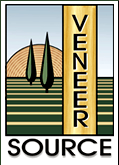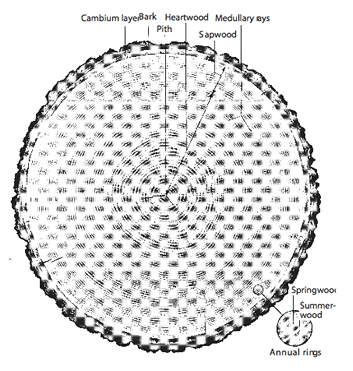







The trunk and its branches: The cross section of a tree shows the following well-defined features in succession from the outside to the center: (1) bark and cambium layer; (2) wood, which in most species is clearly differentiated into sapwood and heartwood; and (3) pith, the small central core. The pith and bark, of course, are excluded from finished lumber.
Most branches originate at the pith, and their bases are intergrown with the wood of the trunk as long as they are alive.
These living branch bases constitute intergrown or tight knots. After the branches die, their bases continue to be surrounded by the wood of the growing trunk and therefore loose or encased knots are formed. After the dead branches fall off, the stubs become overgrown, and subsequently clear wood is formed. All growth in thickness takes place in the cambium layer by cell division. No growth in either diameter or length takes place in wood already formed; new growth is purely the addition of new cells, not the further development of existing cells.
Annual Rings
Most species grown in temperate climates produce well-defined annual growth rings, which are formed by the difference in density and color between wood formed early and late in the growing season. The inner part of the growth ring formed first is called “spring wood," and the outer part formed later in the growing season is called “summer wood."
Spring wood is characterized by cells having relatively large cavities and thin walls. Summer wood cells have smaller cavities and thicker walls, and consequently are more dense than spring wood. The growth rings, when exposed by conventional methods of sawing, provide the grain or characteristic pattern of the wood. The distinguishing features of the various species are thereby enhanced by the differences in growth ring formation. Some tropical species, on the other hand, experience year long even growth which may result in less obvious growth rings.
Softwoods and Hardwoods
Native species of trees and the wood produced by these trees are divided into two botanical classes: hardwoods, which have broad leaves; and softwoods, which have needle-like or scale-like leaves. This botanical classification is sometimes confusing, because there is no direct correlation between calling a species a hardwood or softwood and the hardness or softness of the wood itself. Generally, hardwoods are more dense than softwoods, but some hardwoods are softer than many softwoods. If hardness is a desired characteristic, refer to the Comparative Table of Wood Species later in this book.
Heartwood
Heartwood consists of inactive cells formed by changes in the living cells of the inner sapwood rings, presumably after their use for sap conduction and other life processes of the tree have largely ceased. The cell cavities of heartwood may also contain deposits of various materials that frequently provide a much darker color. Not all heartwood, however, is darker. The infiltrations of material deposited in the cells of heartwood usually make lumber cut therefrom more durable when exposed to weather.  All wood, with the possible exception of the heartwood of Redwood and Western Red Cedar, should be preservative-treated when used for exterior applications.
All wood, with the possible exception of the heartwood of Redwood and Western Red Cedar, should be preservative-treated when used for exterior applications.
Sapwood
Sapwood contains living cells and performs an active role in the life processes of the tree. It is located next to the cambium and functions in sap conduction and storage of food. Sapwood commonly ranges from 25-50 mm [1" to 2"] in thickness. The Maples, Hickories, Ashes, and some of the Southern Yellow Pines and Ponderosa Pine may have sapwood 76-152 mm [3" to 6"] in thickness, especially in second growth trees.
Medullary Rays
Medullary rays extend radially from the pith of the log toward the circumference. The rays serve primarily to store food and transport it horizontally. They vary in height from a few cells in some species to four or more inches in the oaks, and produce the fleck (sometimes called flake) effect common to the quartersawn lumber in these species.
... that managed forests, thanks to their high proportion of young, strong, growing trees, enable CO2 to be extracted?
... that an old, unmanaged forest produces as much CO2 through processes of decomposition and decay as it stores, and that therefore an unmanaged forest contributes nothing to reducing global CO2?


The Veneer Source • 400B Pittman St, Orlando, FL 32801
Phone: 407-423-2252 • Fax: 407-423-1566 • sales@veneersource.com
Phone: 407-423-2252 • Fax: 407-423-1566 • sales@veneersource.com